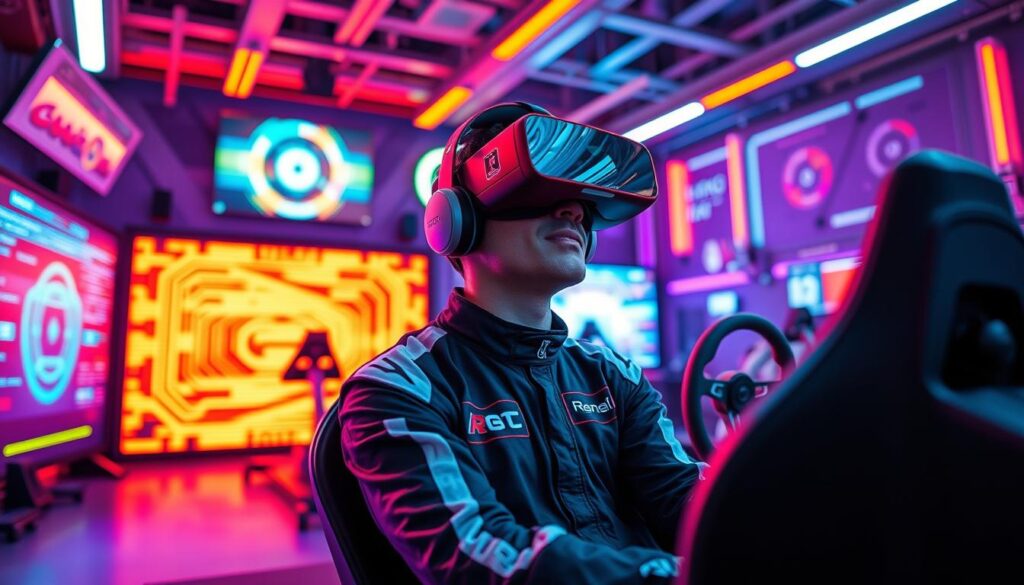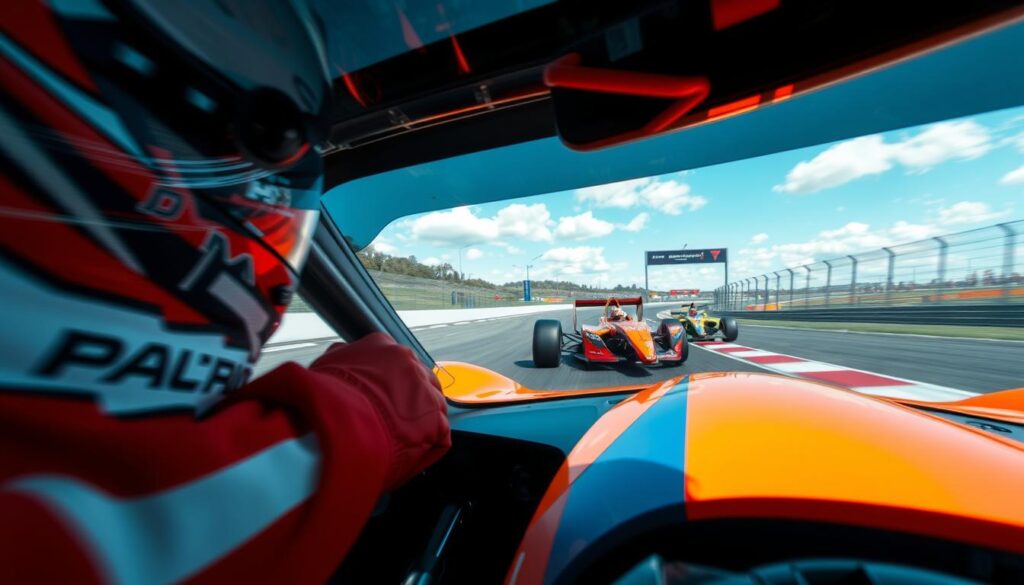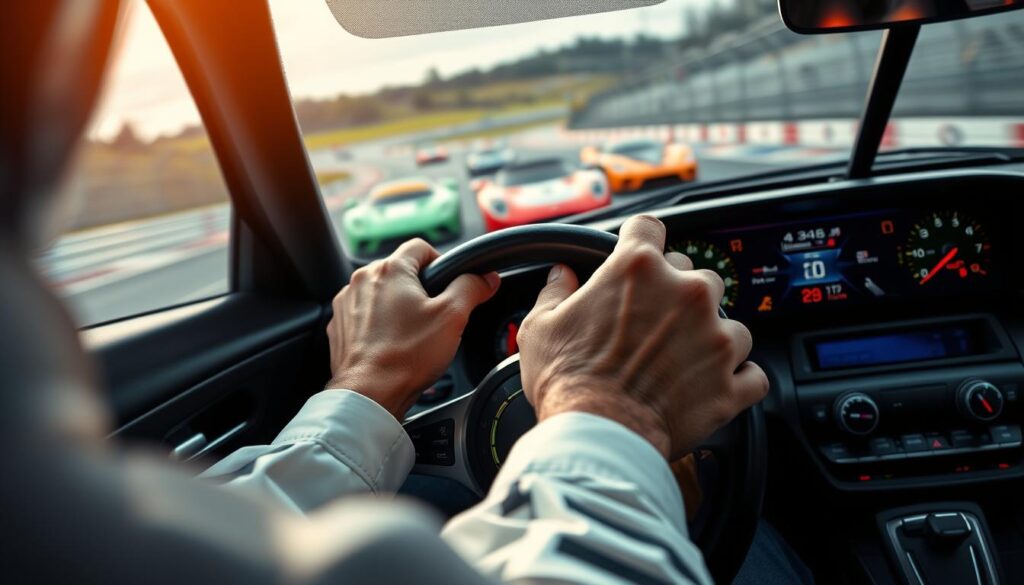As a seasoned race car driver, I’ve learned how vital quick reaction time is. It lets you respond fast to changes and outsmart opponents. This can be the difference between winning and losing.
In this guide, I’ll share tips that have helped me and many others. These strategies will help you sharpen your reaction time and improve your racing skills. Whether you’re a weekend warrior or aiming for the top, these techniques will enhance your performance.
In This Guide
Understanding Racing Reaction Time Fundamentals
Reaction time is key in racing, from Formula 1 to off-road sports. It’s about quickly processing what you see, making fast decisions, and acting fast. Knowing what makes you quick is the first step to getting better at racing.
Components of Quick Response Time
Quick reaction time comes from three main parts: sensory processing speed, making decisions, and acting fast. Your eyes need to spot and understand what’s happening quickly. Then, your brain must decide what to do next. Finally, your muscles must act quickly and accurately.
Why Reaction Speed Matters in Racing
In racing, every millisecond counts. A tiny delay in braking or turning can cost you the win. Being fast lets racers react to the track’s changes, giving them an edge over others.
The Science Behind Split-Second Decisions
Making fast decisions in racing comes from how our brains and bodies work. Racing drills that test your eyes, brain, and muscles can improve your racing skills. They prepare your brain and body for the fast pace of racing.
“In racing, you don’t have time to think; you just react.” – Ayrton Senna, Formula 1 legend
Essential Equipment for Reaction Time Training
As a racer, improving your hand-eye coordination and reaction speed is key. There are special tools and devices to help you train and boost your reflexes. Let’s look at the essential equipment that professional racers use to get better at reacting fast.
Reaction Lights
Reaction lights are a must-have for racers. They flash lights in a random order, asking you to react quickly and correctly. By practicing with these lights, you can get your brain to process visual cues faster. This helps you make quick decisions on the track.
Batak Boards
Batak boards are interactive tools that test your visual and motor skills. They have lights that light up randomly, and you need to press the right buttons fast. Getting good at the Batak board can really improve your hand-eye coordination and reaction time.
Specialized Software
Modern racers also use special software to improve their reaction time. These programs have exercises and simulations that challenge your visual skills, decision-making, and response times. Using this software regularly can sharpen your racing reflexes and give you an edge on the track.
By adding these tools to your training, you can boost your hand-eye coordination and racing skills. Remember, success on the track isn’t just about speed. It’s also about reacting and responding fast.

How to Improve Racing Reaction Time: Step-by-Step Guide
Improving your racing reaction time is key to becoming a better driver. By using specific training and advanced methods, you can make quicker decisions on the track. Here’s how to improve your reaction time step by step.
Basic Training Exercises
Begin with exercises that test your vision and quickness. Racing drills like simple reaction tests, hand-eye coordination, and peripheral vision exercises are good starts. Doing these drills regularly will prepare you for more challenging training.
Advanced Practice Techniques
After mastering the basics, move on to more complex visual perception training. Try anticipation drills, decision-making scenarios, and multi-tasking challenges. These will boost your reaction speed and thinking skills.
Measuring Your Progress
- Use specialized reaction time testing software or apps to monitor your improvements over time.
- Participate in timed racing drills and track your lap times, brake reaction, and other performance metrics.
- Seek feedback from experienced coaches or fellow racers to gain an objective assessment of your progress.
Keep practicing and track your progress with data. This will help you see where you need to improve and focus your training.

“The difference between a good racer and a great racer is often measured in milliseconds. Mastering your reaction time is the key to unlocking your full potential on the track.”
By following this guide, you’ll be on your way to better racing reaction times. You’ll become a stronger competitor on the circuit.
Visual Perception Training for Racers
As a racing fan, improving your visual skills is key. It helps you spot track changes fast and react quickly. Visual training boosts your ability to handle race speed. Learn how to improve your sight and awareness around you.
Enhancing Visual Acuity
Good visual acuity lets you spot dangers quickly. Try exercises that make you focus on small things, like:
- Tracking moving objects with your eyes
- Identifying subtle changes in color or shape
- Differentiating between similar-looking objects
These exercises help your eyes get better at processing info. This boosts your overall visual skills.
Expanding Peripheral Awareness
Peripheral vision is key for seeing what’s happening around you. Try these methods to improve your side vision:
- Scanning the track with your eyes while keeping your head still
- Practicing quick glances to the sides without losing focus on the road
- Incorporating peripheral vision exercises using specialized equipment
Improving your peripheral vision lets you react faster to your surroundings. This is crucial for racing success.

Adding visual training to your racing routine sharpens your anticipation skills and visual perception training. This gives you an edge on the track. With regular practice, you can become a better racer.
Physical Conditioning to Enhance Response Time
As a racer, your physical fitness is key to your reaction time and performance. Strength training, cardio, and flexibility help improve your hand-eye coordination and reaction speed.
Strength Training Benefits
Strength training boosts your reaction time. It makes your body stronger and more stable. This lets you react faster and more accurately in racing.
- Do compound exercises like squats, deadlifts, and pull-ups for full-body strength.
- Focus on exercises that match racing movements, like core workouts.
- Keep increasing the weight and intensity to challenge your muscles and adapt.
Cardiovascular Exercises
Cardio fitness is vital for quick reaction times. Regular aerobic activities boost endurance and stamina. This helps you stay focused and quick during races.
- Try high-intensity interval training (HIIT) for better cardio and anaerobic capacity.
- Activities like cycling, running, or swimming are great for cardio.
- Balance your training with steady-state and interval cardio sessions.
Flexibility and Mobility Work
Flexibility and good range of motion are crucial for quick reactions. Tight muscles and limited mobility hinder fast, precise movements.
| Exercise | Benefits |
|---|---|
| Yoga | Improves flexibility, balance, and body awareness. |
| Dynamic Stretching | Prepares the body for intense movements by increasing joint mobility. |
| Foam Rolling | Reduces muscle tightness and improves recovery, enhancing reaction time. |
Adding these physical conditioning techniques to your routine can unlock your full potential. It will give you an edge on the racetrack.

Mental Focus Techniques for Better Reaction Speed
In the world of racing, staying mentally sharp is key for quick reactions. Professional drivers use psychological strategies to stay focused and avoid getting tired. By learning mental focus techniques, you can improve your brain’s performance and beat the competition.
Visualization is a powerful tool for racers. They imagine themselves on the track, making fast decisions, and reacting quickly. This mental exercise prepares your mind for success, helping you react better in real situations.
- Visualize yourself executing flawless maneuvers and making lightning-fast reactions
- Imagine the sights, sounds, and sensations of being behind the wheel during a race
- Regularly practice this mental rehearsal to ingrain the desired behaviors and responses
Mindfulness meditation is also valuable. It trains your brain to stay present and focused, helping you ignore distractions. Regular meditation builds mental discipline and focus, essential for quick decision-making.
“Meditation has been a game-changer for my racing performance. It helps me stay grounded and present, no matter how chaotic the situation on the track gets.”
Adding mental focus techniques and cognitive exercises to your training can improve your reaction times. With regular practice, you can sharpen your mind for racing success.
Simulator Training and Virtual Practice Methods
Modern technology has become a key ally in improving your racing skills. Racing simulators and virtual reality apps let you practice safely. You can work on your skills without the dangers of real racing.
Best Racing Simulators
The world of racing simulators has grown a lot. Now, there are many software and hardware options for serious racers. Some top simulators include:
- iRacing – A realistic online racing platform with lots of licensed cars and tracks.
- Assetto Corsa Competizione – A GT3 and GT4 racing simulator known for its detailed physics.
- rFactor 2 – A versatile platform for many racing types, from formula cars to touring cars.
Virtual Reality Applications
Virtual reality (VR) has made racing simulators even better. It creates a fully immersive 360-degree world. By using a VR headset, you can feel like you’re really driving. This helps with quick decisions and racing drills in a virtual space. Top VR racing solutions include:
- Assetto Corsa with VR support
- rFactor 2 with VR compatibility
- iRacing with dedicated VR functionality
These platforms offer a more realistic experience. They also help you collect and analyze data. This way, you can see how you’re doing and where you can get better.
“Simulator training has become an indispensable tool for professional racing drivers, allowing them to hone their skills and prepare for real-world challenges in a safe, controlled environment.”
Nutrition and Recovery for Optimal Performance
To keep your sensory processing speed and motorsport reaction time sharp, eating right and recovering well are key. The right foods can boost your performance and how long you can keep going.
Before racing or intense training, eat complex carbs, lean proteins, and healthy fats. These give you energy that lasts and help your muscles recover. Good choices include whole grains, nuts, seeds, and lean meats.
During the race, drink water or sports drinks to stay hydrated. They replace lost fluids and minerals, keeping you focused and avoiding tiredness.
After racing or working out, refuel with protein and carbs within an hour. Choose foods like Greek yogurt, chocolate milk, or a protein shake with fruit to start muscle repair.
- Prioritize complex carbohydrates, lean proteins, and healthy fats in your pre-race meals
- Stay hydrated during the event with water or electrolyte-rich drinks
- Refuel with a protein and carbohydrate-rich snack immediately after your race or training
By eating well and recovering right, you can improve your sensory processing speed and motorsport reaction time. This gives you an edge on the track.
“Proper nutrition and recovery are crucial for maintaining peak performance and reaction time on the race track.”
Common Mistakes That Slow Down Reaction Time
To get better at racing reaction time, you need more than just to practice. You also have to watch out for common mistakes that slow you down. These mistakes can be physical habits or mental barriers. Let’s look at what to avoid for faster track responses.
Physical Errors to Avoid
One big mistake is ignoring proper form and technique. Bad foot placement, jerky movements, and poor balance can slow you down. Keep a stable, centered stance with your weight evenly spread. Smooth, controlled movements are crucial for cognitive exercises and quick thinking.
Another mistake is not being flexible enough. Tight muscles and limited movement can slow your reflexes. Make sure to stretch and work on your mobility regularly. This will help you react faster on the track.
Mental Blocks and Solutions
- Fear of Failure: Being too afraid of mistakes can slow you down. Stay positive and focus on the process, not the outcome.
- Lack of Concentration: Distractions and mind-wandering can make you less sharp. Use mindfulness to stay focused.
- Complacency: Being too confident can make you sloppy. Always try to improve and keep learning.
Improving reaction time is about both physical and mental skills. Stay alert, work on your technique, and build a strong, focused mindset. This will help you respond quickly on the race track.
Real-World Practice Strategies
Improving your racing reaction time goes beyond the gym or simulator. To really sharpen your reflexes, you need to practice in real-world settings. Start by adding racing drills to your training, like cone exercises that test your quick reaction to changes.
On race day, being prepared is essential. Get to know the circuit, study the track map, and imagine the layout to spot potential challenges. This will help you make fast decisions during the race. Also, have a pre-race routine to keep you focused and sharp.
Keeping your reflexes sharp under pressure is key. Practice your reaction time in race-like conditions. Do timed drills that feel like a real competition, with all the noise and distractions you’ll face on the track. This training will help you respond well in high-pressure situations, making you better at real-world racing.

